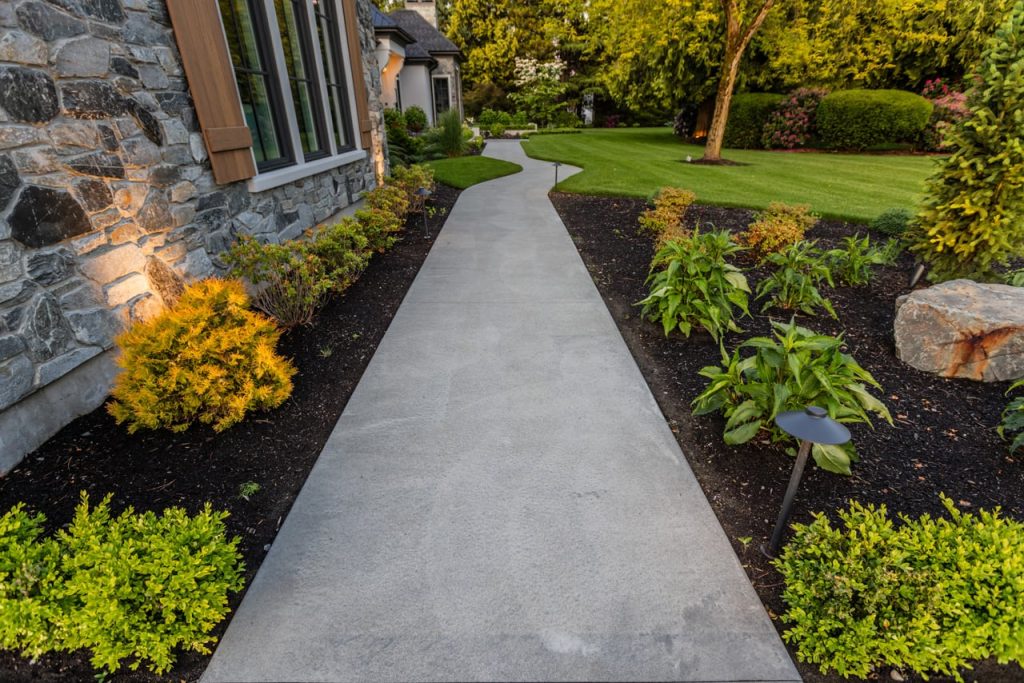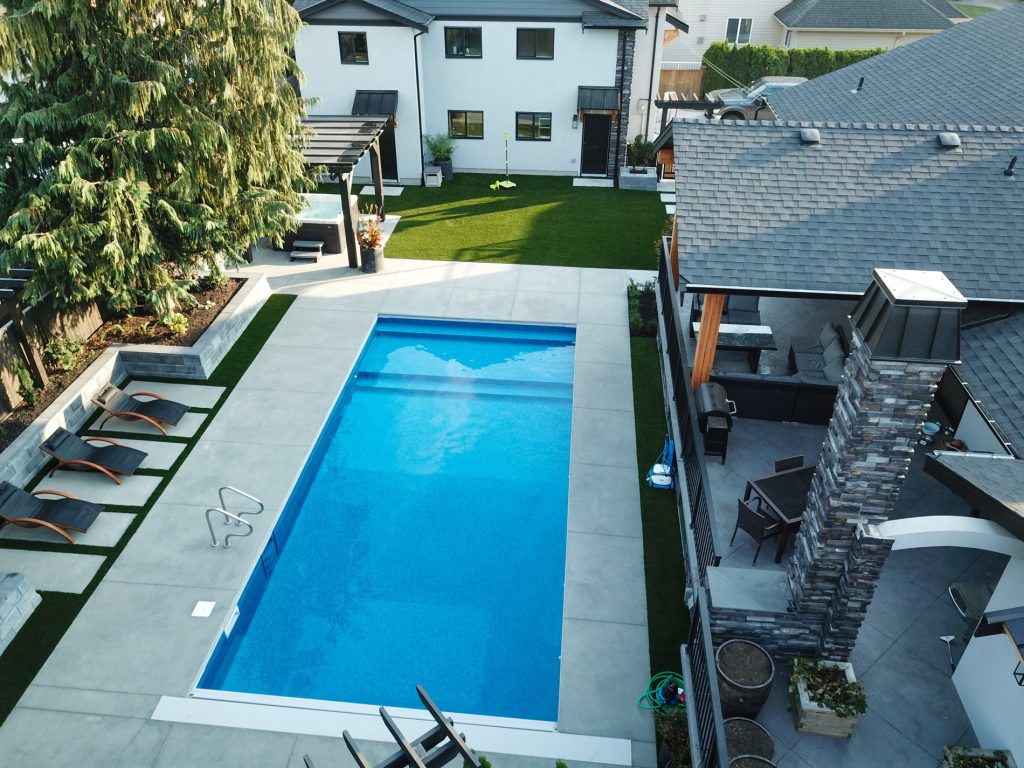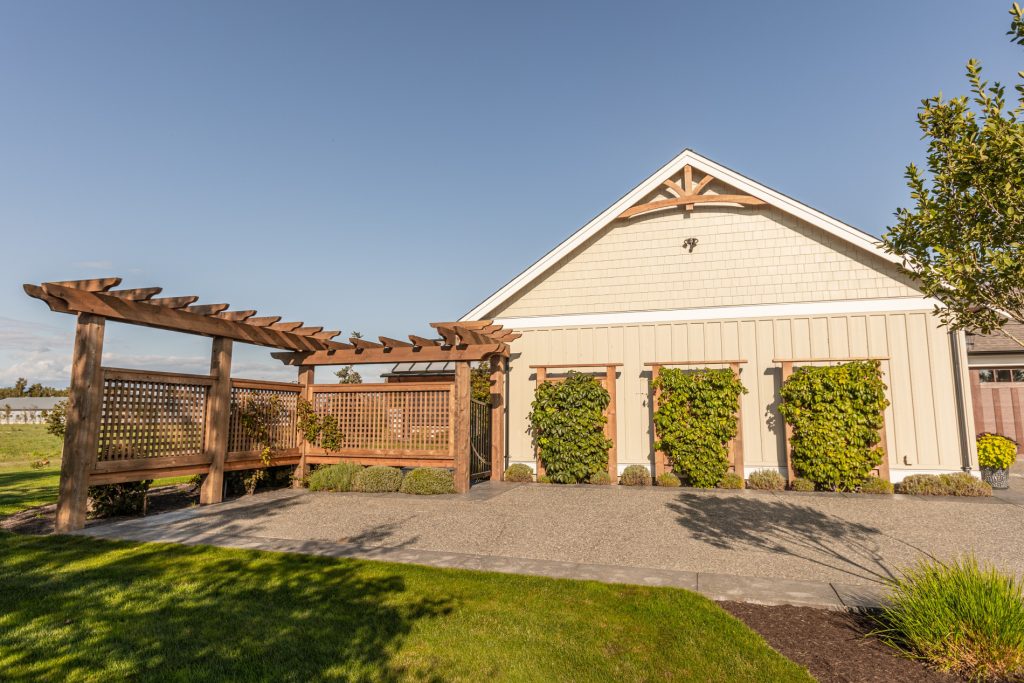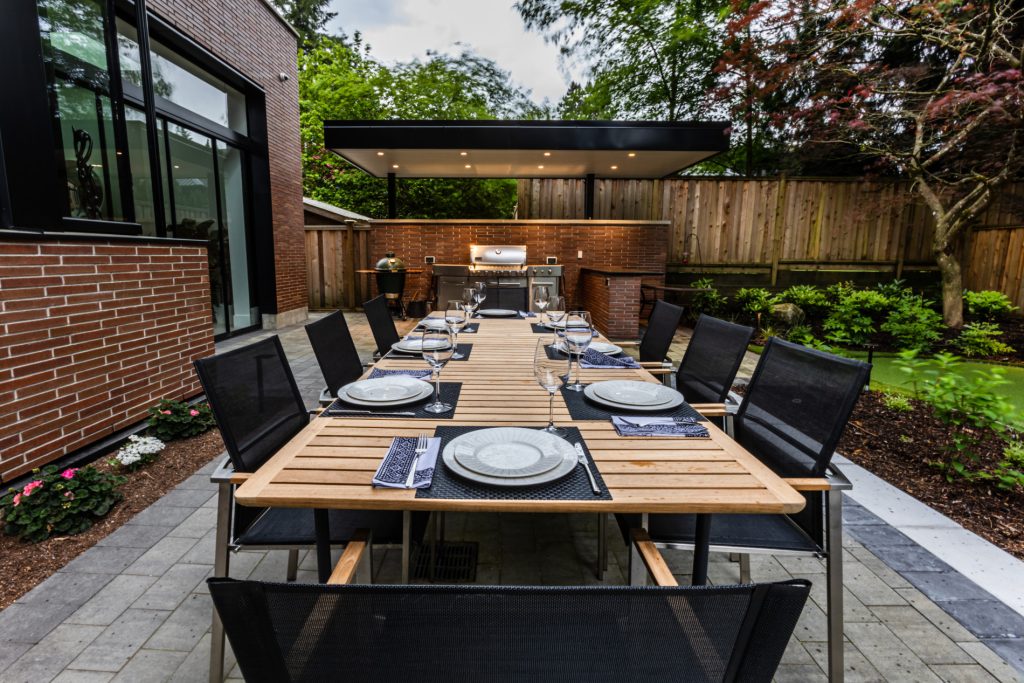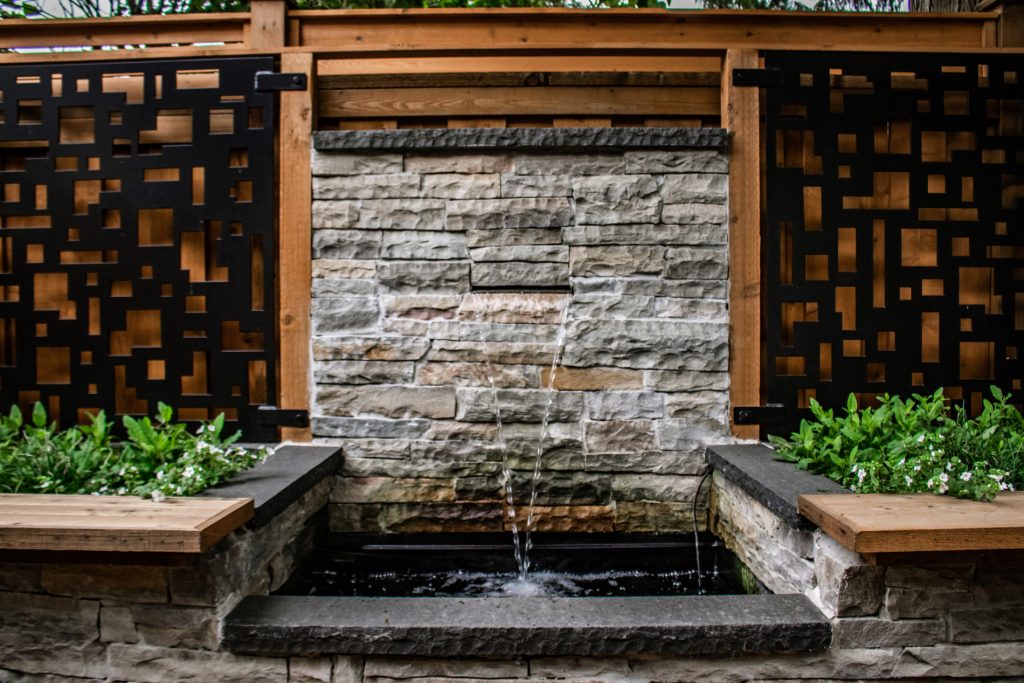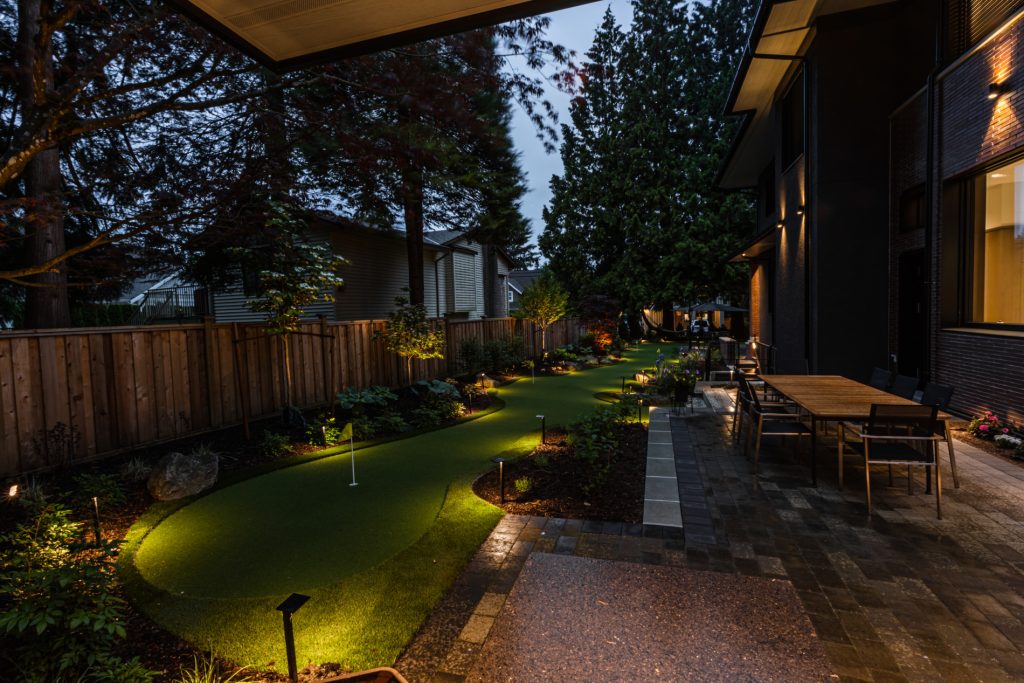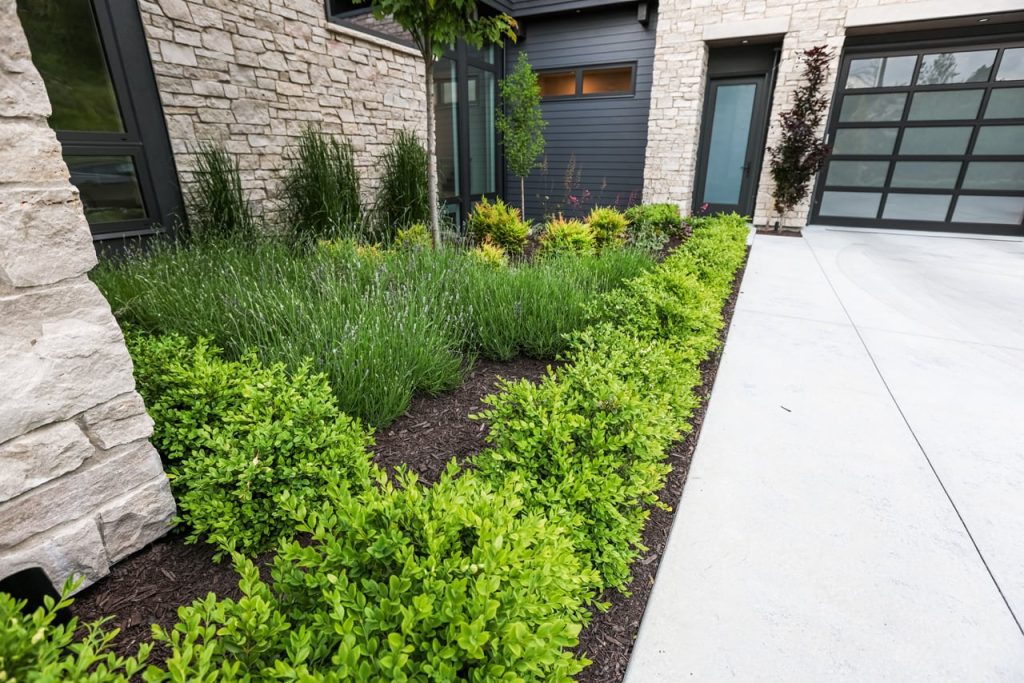Best Landscaping Materials: Pros, Cons & Costs (2025 Guide)

Best Landscaping Materials: Pros, Cons & Costs.
Choosing the right landscaping materials can feel overwhelming. Pick the wrong option, and you could end up with rotting walls, struggling plants or constant upkeep that drains your time and money.
At Jovak Landscape and Design, we’ve helped hundreds of homeowners in the Fraser Valley transform their backyards from unusable spaces, to an extension of their indoor living space. From patios and walls to lawns and lighting, we’ve seen firsthand which materials stand the test of time and which ones don’t.
In this guide, we’ll walk through the pros, cons, and costs of today’s most popular landscaping materials so you can confidently pick materials for your design that will create an outdoor space that’s beautiful, durable, and right for your budget.
What Are the Best Materials for Hardscaping Projects?
A new landscape, or outdoor living space will include a number of different hardscaping features, including patios, walkways, retaining walls, steps, and outdoor living elements like fireplaces or kitchens. The best materials depend on your project’s purpose (functionality), budget, aesthetic preferences, and local climate.
Below, we’ve broken down the most popular hardscaping materials, their benefits, and top suppliers we use to help you choose wisely.
1. Pavers: Perfect for Patios, Walkways, and Driveways
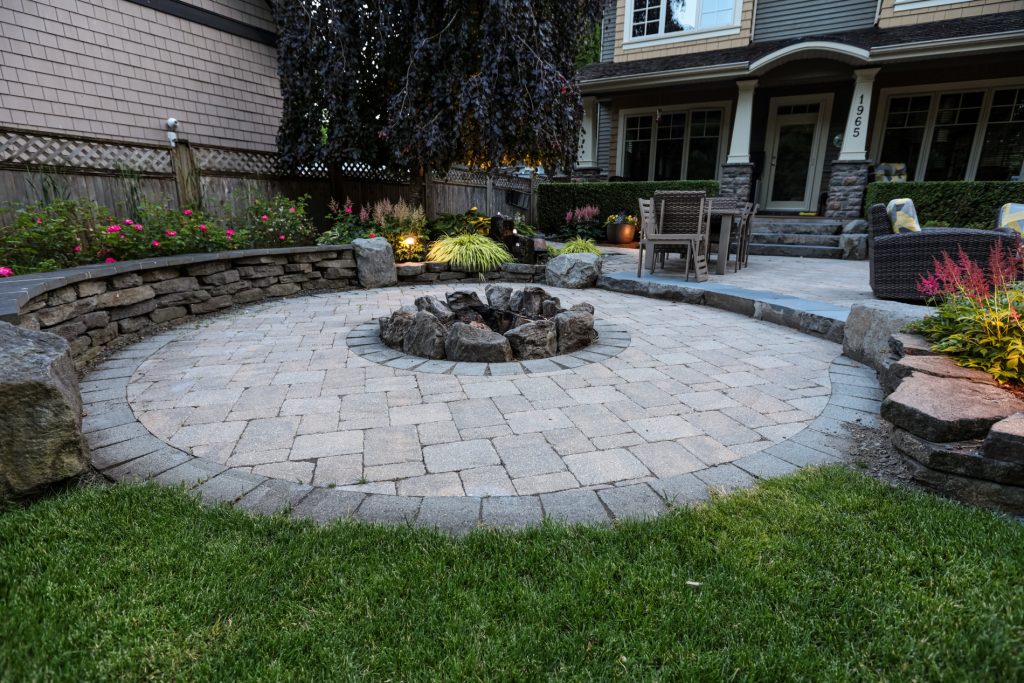
Main Infill Paver Products:
- Colours: Available in a spectrum of hues – natural tones (greys, browns, beiges), vibrant reds, and modern blacks. Choose colours that complement your home’s exterior or landscape theme.
- Patterns: Options include herringbone, basketweave, running bond, and more. The pattern affects both aesthetics and structural integrity.
- Border Pavers: Used to frame the main infill pavers, adding contrast and definition.
- Border Colours: Match or contrast with the main paver colour for a cohesive or bold look.
- Border Sizes: Can be a number of different sizes in order to contrast the main paver.
Pro’s of Pavers:
- Durability: Resistant to cracking, fading, and weathering.
- Low Maintenance: Easy to clean and replace individual pavers if damaged.
- Design Flexibility: Endless combinations of colours, shapes, and patterns.
Con’s of Pavers:
- Pavers can shift if the base, edging or filler sand is not installed properly – especially on areas with vehicle traffic.
- Weeds can grow through the gaps in your paving stones.
Cost of Pavers:
- Moderate, with prices ranging from $30-$40 per square foot (installed), depending on the brand and style.
Top Paver Manufacturers:
- Belgard: Known for premium pavers with multiple textures and colours.
- Barkman Concrete: Offers durable, stylish pavers for residential and commercial projects.
- Basalite: Wide selection of pavers and slabs for various applications.
- Newstone Group: Specializes in high-quality, modern paver designs.
2. Block Walls: Best retaining wall materials
Block walls are essential for retaining walls, garden borders, or raised planters. They provide the structural support needed to retain soil while also improving the landscape’s visual appeal.
Wall Blocks and Caps:
- Wall Blocks: Modular concrete blocks designed for easy stacking and stability. Can be rough or smooth finish depending on your preferences (modern or classic look).
- Caps: Finishing pieces that give the wall a finalized look. They fit on top of the concrete blocks and are often mortared or glued to the block.
Pro’s of Block Walls:
- Strength: Ideal for retaining soil or creating terraced landscapes. Great for adding depth to your project.
- Aesthetics: Available in various textures and colours to match your home and design.
Con’s of Block Walls:
- Higher upfront cost.
- Can look manufactured and less ‘natural’.
Cost of Concrete Block Walls:
- $75–$85 (installed) per square foot, depending on the brand and complexity.
Top Block Wall Manufacturers:
- Belgard: Offers robust retaining wall systems with natural stone-like finishes.
- Barkman Concrete: Durable and stylish options for retaining and landscape walls.
- Basalite: High-quality blocks for structural and decorative walls.
- Newstone Group: Specializes in modern, versatile wall systems like the Dorado Wall.
3. Timber Walls: Rustic and Cost-Effective
Timber walls, made from pressure-treated lumber, offer a natural, rustic look for retaining walls or garden beds.
Timber Wall Materials:
- Pressure-Treated 4×6 Lumber: Cheaper and more versatile for smaller projects.
- Pressure-Treated 6×6 Lumber: Stronger and ideal for larger retaining walls, but more expensive per lineal foot.
Pro’s of Timber Walls:
- Warm Aesthetic: Complements natural landscapes and wooden structures.
Con’s of Timber Walls:
- Shorter lifespan than concrete or boulder walls
- If not installed correctly, can bow out.
Cost of Timber Retaining Walls:
- Anywhere from $30-$65 per square foot
4. Boulder Walls and Accent Boulders: Natural and Textured
Boulder walls add a bold, natural element to landscapes, perfect for retaining walls or decorative features.
Boulder Wall Options:
- Kelmore Boulders: Irregular shapes, blue/grey tones, ideal for a rugged look.
- Armstrong Boulders: More refined (rectangular/square), with natural grey, orange, and sandy hues.
- Sizes: Available in 2ft, 3ft, and 4ft diameters for varying project scales.
Pro’s of Boulder Walls:
- Natural Beauty: Eye-catching, and brings texture and character to the landscape.
- Durability: Extremely resistant to weathering and erosion.
Con’s of Boulder Walls:
- Expensive to install due to heavy machinery,
- Limited precision (can look a little rough)
- Takes more space than block walls.
Cost of Boulder Walls:
- $65–$85 per square foot, depending on boulder size, type and installation.
5. Steps and Stairs: Creating levels in your outdoor living space.
Steps and stairs ensure safe navigation across elevation changes in your landscape while also adding texture and style to your space.
Materials for Steps:
Concrete Steps:
Pros: Durable, customizable with colours and textures.
Cons: Could crack or chip- Natural Stone Steps:
Pros: Textured, yet classic look with excellent durability.
Cons: More expensive, can be slippery when wet. - Timber Steps with 3/4 clear
Pros: Natural, rustic material.
Cons: Shorter lifespan, can weather over time.
Top Step Suppliers:
- Barkman Concrete: High-quality concrete steps for residential projects.
- Belgard: Stylish landings and steps for seamless integration.
- Sanderson Concrete: Custom concrete solutions for steps and hardscapes.
- Bedrock Natural Stone: Premium natural stone steps.
- Northwest Landscape Supply: Wide range of step materials.
6. Concrete Patios, Pathways, and Driveways: Customizable and Durable
Concrete is a versatile material for patios, pathways, and driveways, offering endless design possibilities through colours and stamped patterns.
Pro’s of Concrete:
- Customization: Stamped patterns mimic stone, brick, or tile.
- Durability: Withstands heavy traffic and harsh weather.
Con’s of Concrete
- Can crack and stain easily
- Can be hot underfoot
- If needing repair, often means replacement
Cost of concrete:
- $30-$40 per square foot, depending on design complexity and finish
7. Pools and Hot Tubs: Fibreglass vs. Vinyl vs. Concrete
Pools and hot tubs bring a whole new element of outdoor living, offering relaxation and entertainment for your weekend parties or a quiet evening with your spouse.
Pool Types:
- Fiberglass:
- Pro’s: Low maintenance, quick installation
- Con’s: Limited sizes, availability
- Cost: $130,000-$150,000+incl. auto-covers
- Vinyl:
- Pro’s: Affordable, customizable shapes and sizes
- Con’s: Replace the liner approx. every 10 years, leaks in the liner
- Cost: $100,000-$120,000+ incl. auto-covers
- Concrete:
- Pro’s: Highly customizable, durable
- Con’s: Resurfacing, harder to maintain water chemistry, bigger upfront cost
- Cost: $175,000-$200,000+
Hot Tubs/Spas:
- Pro’s: Compact and ideal for year-round use.
- Con’s: High maintenance
- Cost: $11,000–$25,000 depending on size and features.
8. Woodworking: Gates, Fences, Pergolas, and Decks
Woodworking adds rustic beauty and can offer functionality to outdoor spaces.
Benefits: Aesthetic appeal and a rustic, warm, natural look.
Options:
- Gates/Fences: Provides privacy and security, made from cedar, pine, metal or composite.
- Pergolas/Trellises/Arbors: Create statement pieces, privacy screens or natural features to your landscape.
- Decks: Extend your living spaces, typically made from pressure-treated wood, cedar or composite materials.
- Outdoor Covers/Living Spaces: Protect patios or decks from weather. Extend outdoor living to year round.
Decking Prices installed:
- Wood:
- Pro’s: A cheaper option. High availability. Natural look.
- Con’s: Wood can fade over time. Requires maintenance.
- Cost: $45-$65
- Composite:
- Pro’s: Low maintenance, advancing technology in products.
- Con’s: More expensive option. Can be hot to the feet. If not installed properly, it can warp.
- Cost: $55-$95
- Specialty (eg. White Cedar):
- Pro’s: It’s uniqueness. Stands out. Conversation starter.
- Con’s: Very expensive. Requires maintenance to stay looking good.
- Cost: $95+
- Pergolas
- $3500-$20,000 depending on size, features and materials of which there are many to choose from!
9. Outdoor Living: BBQs, Fireplaces, and Kitchens
Built-in kitchens, BBQs, and fireplaces expand your indoors to the outdoors. Turning your backyard into a functional living space can add value to your home and improve your life!
Benefits:
- Entertainment Value: Perfect for hosting gatherings!
- Property Value: Increases home resale value.
- Cost: $5,000–$50,000, depending on features included.
10. Lawns: Grass vs Artificial Turf
Lawns (natural and artificial) provide a soft play space for your pets and your kids (and you!) Green space is important in a landscape, adding a vibrant colour and a tidy space to run around!
Options:
- Grass:
- Pro’s: Natural and affordable.
- Con’s: Requires ongoing maintenance and watering.
- Cost: $7/10sqft (not installed)
- Suppliers
- Artificial Turf:
- Pro’s: Low maintenance and durable
- Con’s: Can be hot to walk on in the summer. May need to install irrigation to cool off.
- Cost: $20-$30 per square foot (installed).
- Suppliers
11. Water Features and Irrigation
Water features can add to the tranquility of your space, and could be paired as a statement in the landscape, while irrigation ensures healthy landscapes, keeping your plants and grass alive.
Water Features:
- Types: Fountains, river rock, ponds, waterfalls.
- Cost: $1,000–$20,000, depending on complexity
- Supplier
Irrigation:
- Benefits: Saves water, maintains plant and lawn health.
- Cost: $8,000–$15,000 for a standard system/yard or $25,000+ for an acreage.
12. Lighting: Safety and Accent Landscape features
Outdoor lighting improves safety and highlights your landscape’s beauty.
Types:
- Up lights: Highlight trees or architectural features.
- Path lights: Illuminate walkways.
- Step lights: Ensures safety while on stairs.
Cost:
- $100–$700 per fixture, plus installation.
Suppliers:
13. Edging: Define Your Landscape
Edging separates landscape elements, such as river rock and mulch from grass.
Aluminium Edging:
- Benefits: Durable, flexible, and sleek.
- Cost: $5 per linear foot.
Plastic Edging:
- Benefits: Lower price point, flexible
- Cost: $3 per linear foot
14. Best Plants and Trees: Adding Life to Your Landscape
Plants and trees are essential for your landscaping. They soften hardscaping elements, add colour, and create a balanced, inviting outdoor space. They can enhance privacy, provide shade, and promote garden health through insect attraction.
Plant Options:
- Perennials: Long-lasting plants like hostas, daylilies, or lavender that return year after year.
- Annuals: Vibrant, seasonal plants like petunias or marigolds for bold colour.
- Shrubs: Evergreen or deciduous options like boxwood or hydrangeas for structure and privacy.
- Ground Covers: Low-growing plants like creeping thyme or sedum to fill spaces and reduce erosion.
Tree Options:
- Deciduous Trees: Maples or birch for seasonal colour and shade, typically $100–$500 per tree.
- Evergreen Trees: Spruce or cedars for year-round privacy and windbreaks, $150–$600 per tree.
- Ornamental Trees: Japanese maples or flowering cherries for focal points, $200–$800 per tree.
Benefits of Plants and Trees:
- Aesthetic Appeal: Add texture, color, and life to your landscape.
- Environmental Impact: Reduce heat, and support local wildlife.
- Property Value: Mature trees and well-placed plants can increase home value by up to 15%.
- Cost: Plants range from $5–$50 per plant; trees range from $100–$800, depending on size and species.
Plant and Tree Suppliers/Advice:
- Cedar Rim: Offers a variety of plants, shrubs, and trees suitable for hardscaping projects.
- Local Nurseries: Check local garden centers for climate-appropriate species and expert advice.
Considerations:
- Choose plants and trees suited to your local climate and soil conditions. Your designer should offer advice with this.
- Plan for maintenance, such as watering, pruning, and fertilizing.
- Use native plants to reduce water usage.
How to Choose the Right Materials for Your Project
There are so many options you can choose from for your project. Your landscape designer can help with suggestions and narrowing down your selections.
- Consider your Goals: Are you prioritizing aesthetics, durability, or budget?
- Consider Climate: Choose materials, plants, and trees that withstand local weather conditions.
- Maintenance: Low-maintenance options like pavers, artificial turf, or evergreen shrubs are ideal for busy homeowners.
- Match Aesthetics: Ensure materials and plants complement your home and landscape design.
- Set a Budget: Balance quality and cost to avoid overspending.
Pro Tip: Request samples from suppliers like Belgard or Barkman for hardscape materials and visit local nurseries to select plants and trees that thrive in your area.
Frequently Asked Questions (FAQs)
What is the most durable hardscaping material?
Concrete pavers and natural stone are among the most durable, with lifespans of 20–50 years when properly maintained.
How much does a hardscaping project cost?
Costs vary widely depending on size, site access and materials chosen:
- Pavers: $30–$40 per square foot.
- Retaining walls: $30–$85 per square foot.
- Pools/hot tubs: $25,000–$200,000+.
- Plants and Trees: $5–$50 per plant, $100–$800 per tree.
- Projects could range from $5,000 (a small backyard project) to over $500,000 (a luxury landscape and outdoor living space). See our article: Landscaping Costs in 2025: Price Ranges, Factors & Budget Guide to learn more!
Where can I find high-quality hardscaping materials and plants?
Trusted suppliers include Belgard, Barkman Concrete, Basalite, Newstone Group, and Cedar Rim or local nurseries for both hardscaping materials and plants.
How do I maintain hardscaping materials and plants?
- Pavers: Sweep/blow off regularly and reseal every 2–3 years.
- Timber: Apply clear coat sealant to prevent rot.
- Concrete: Clean with mild detergent and reseal as needed.
- Plants, lawns and Trees: Water, prune, and fertilize as needed; choose native species for lower maintenance.
Conclusion
Choosing the best hardscaping materials for your hardscaping project, can feel overwhelming, especially when every option looks appealing. Now that you have a better understanding of the pros and cons of each material, you’re more equipped to make a choice that matches your budget, style and climate. Your next step could be exploring our Pricing Calculator, to see how these materials fit into your project. At Jovak Landscape and Design, we’re here to help you build an outdoor space that is beautiful, functional and will last long into the future – a space where you can create lasting memories!

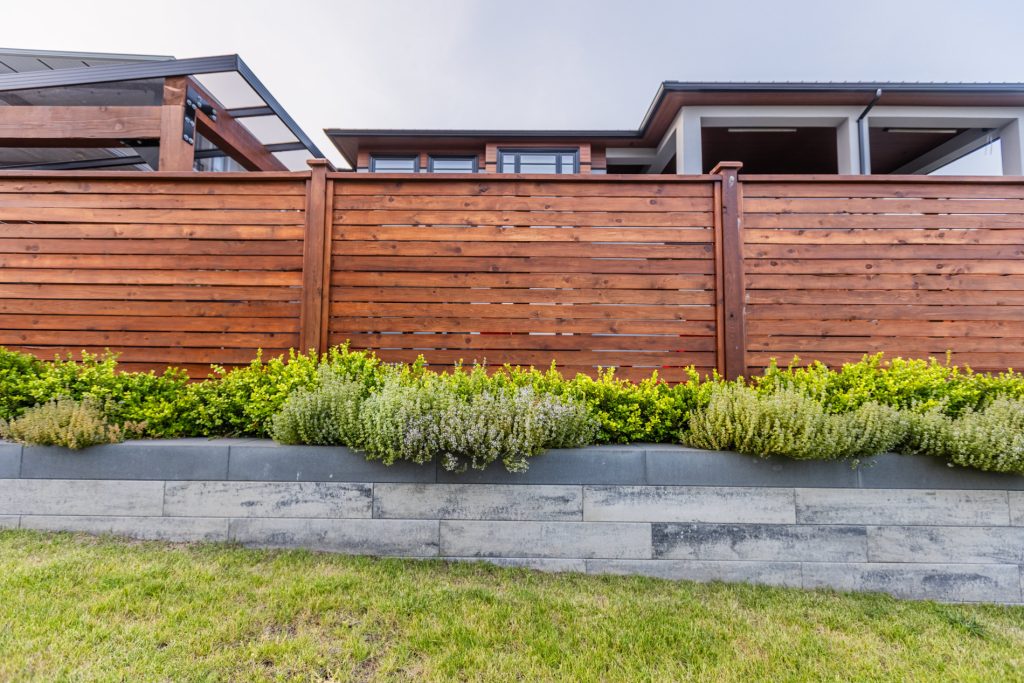
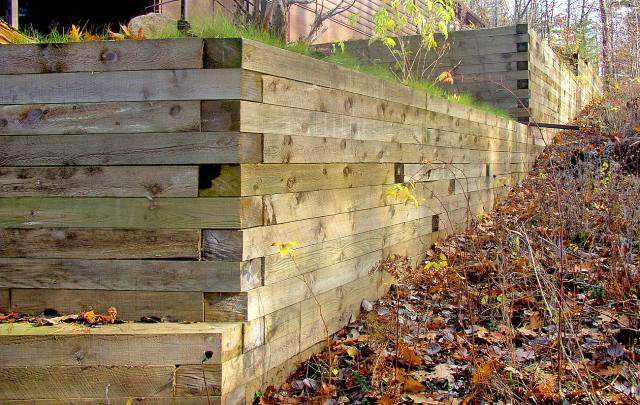
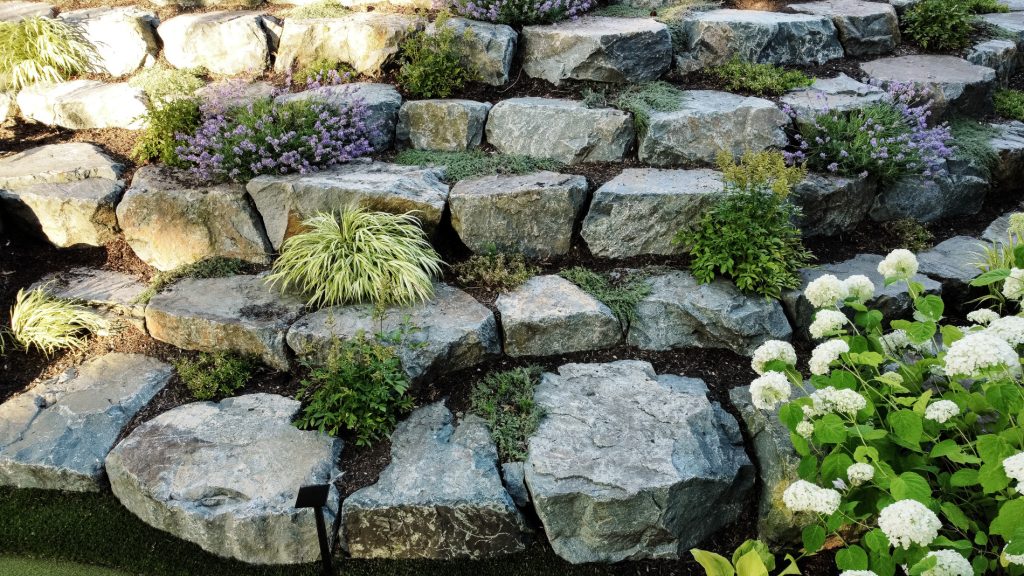
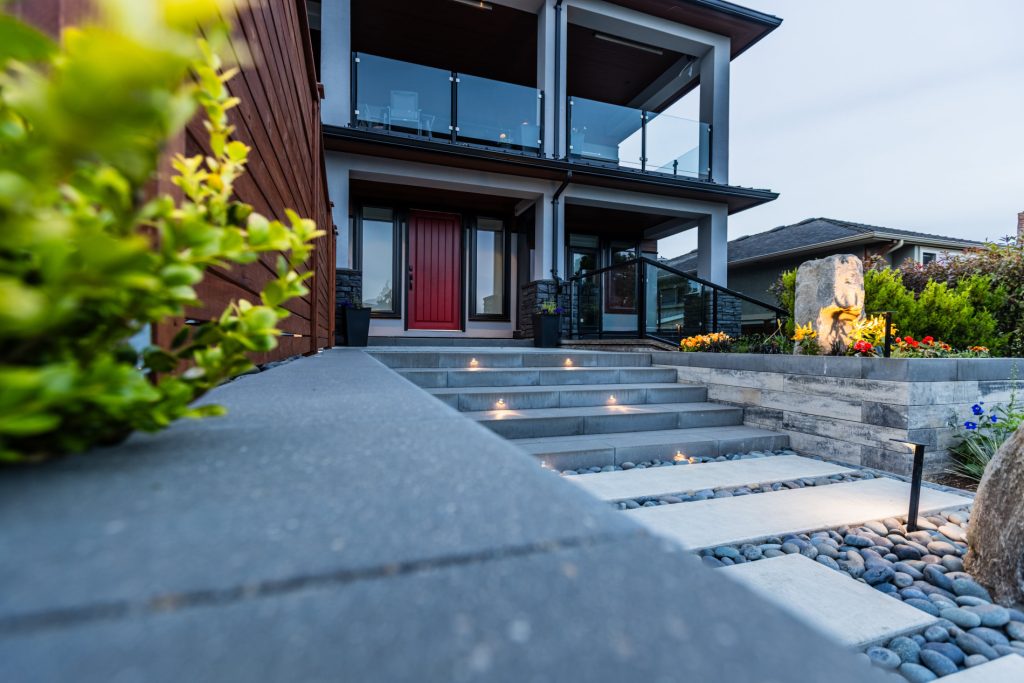 Concrete Steps:
Concrete Steps: